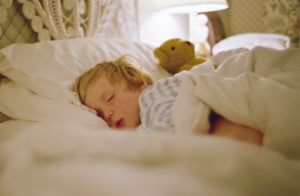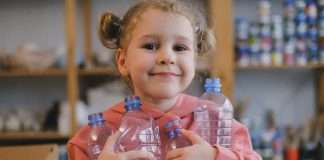
With the new Ghostbusters movie opening, what better time to talk about sleep terrors (ST)! While some people are terrified by green slime, ST are the stuff of nightmares for many parents. But the good news is, I’m here to reassure you- ST are generally harmless and most kids grow out of them! Here is a quick guide to what might be waking your little ones at night and how best to respond.
Sleep phases: First let’s talk a little bit about sleep in general. There are two general sleep phases:
1) Non-REM (Rapid Eye Movement) sleep: When kids first fall asleep, they are in what neurologists call “slow wave sleep,” which is when their brains are very slowed down and kids are very hard to wake up. This phase lasts the first 1-2 hours after your child falls asleep. The slow wave phase is the reason we can sometimes carry our kids upside down and bump their heads on doorframes when asleep and they won’t even flinch. The first third of the night, kids are mostly in this deep sleep phase, and can have 1-2 cycles of non-REM sleep before moving
into…
2) REM sleep: the more active sleep phase, when dreams (and nightmares) occur. This sleep phase occurs in 90-minute cycles. REM sleep is predominantly found in the second half of the night.
What are sleep terrors (ST)?
Also known as night terrors, a ST are an automatic sleep behavior that occur most commonly in young children. During a sleep terror, a young child will often cry out or scream, and appear frightened, agitated or panicked. They may also appear confused, clumsy, or speaking incoherently. And the tricky part is, despite appearances, your child is actually deeply asleep when this is happening.
This is because night terrors occur when kids are in that slow wave sleep phase I mentioned earlier. What happens is, something (we don’t really know what) can disrupt sleep and arouse the “automatic behavior” part of the brain, but the rest of the brain stays deeply asleep in the slow wave phase. Each of us has a different “automatic behavior” mode, but at younger ages the default behavior is typically crying and screaming. In older kids and adults, this automatic behavior presents more as sleepwalking and other semi-purposeful behavior, like eating, speaking nonsensically, or peeing off the balcony (everyone had that friend in college, amiright?). The good news is, since the kid’s brain is still in the slow wave phase, he or she is not even aware that their automatic mode was activated and will never remember it in the morning. So really, ST are hardest for the parents, who have to watch this upsetting behavior happen.
Sleep terrors typically last for only about 5-10 minutes, but can be as long as 20-30 minutes. They are fairly common, occurring in 10-30% of children, and potentially more since a lot of ST go unrecognized. Here’s the good news: they are not caused by nightmares or bad dreams; are NOT a sign of psychological problems or the result of any sort of traumatic event; and they do NOT cause any psychological harm to the child.
Moreover, most kids outgrow ST by Kindergarten, as their slow wave sleep phases decrease. ST run in families, and those who have ST are more likely to sleepwalk when they are older.
Why Do ST happen? Sleep terrors are more likely to occur when your child isn’t getting enough sleep. This is because when you have been sleep deprived, your body gets more deep sleep (slow wave phase) as a way of trying to “catch up” on sleep. The more deep sleep, the more likely a sleep terror will occur. So anything that results in a child losing sleep, such as dropping a nap or an irregular sleep schedule, may trigger a sleep terror in a child who may be prone to having one. Other triggers include: snoring, sleep apnea, fever/illness, sleeping with a full bladder, sleeping in a new or noisy environment, or general stress.
How Should I respond when my child is having a ST?
1) Keep your child safe. On the off chance that your child sleepwalks during a ST, be sure to lock all outside doors and secure all windows, especially if their bedroom is on the second floor. You can even set an alarm on your child’s door (like a bell, for example) that will notify you if your child is up and about.
2) Don’t try to wake your child. It won’t help and it may even make your child more agitated.
3) Make sure your child is getting enough sleep. Encourage naps and consider moving bedtime earlier if your child seems tired or is having regular ST.
4) Maintain a regular sleep schedule.
5) Look for signs of other sleep problems. If your child takes a long time to fall asleep, snores, or is otherwise not getting a good night’s sleep, it is worth seeing your pediatrician. Addressing these sleep issues can decrease or even eliminate ST.
6) Avoid caffeine. This stimulant can disrupt your child’s sleep.
7) Consider additional treatment. In most cases, ST do not require any specific treatment. However, if the automatic behaviors result in injury, violence or are causing serious disruption to the household, treatment may be necessary. Consult with your pediatrician to discuss options including medications or behavior modification techniques.
So then what, exactly, is a Nightmare?
A nightmare is a frightening dream that is associated with REM sleep, not the slow wave phase. This means nightmares are more likely to occur after your child has been asleep for several hours. Moreover, a child is likely to remember their nightmares, especially if they wake up immediately afterwards. In this instance, comforting and reassuring your child during or after a nightmare is helpful. Things that might trigger a nightmare include anxiety, traumatic events, stress, or medications that interfere with REM sleep.
Special thanks to my good friend, Dr. Tom Dye, MD, a Pediatric Neurologist and Assistant Professor at Cincinnati Children’s Hospital Medical Center, and the following sites for their information and resources:















